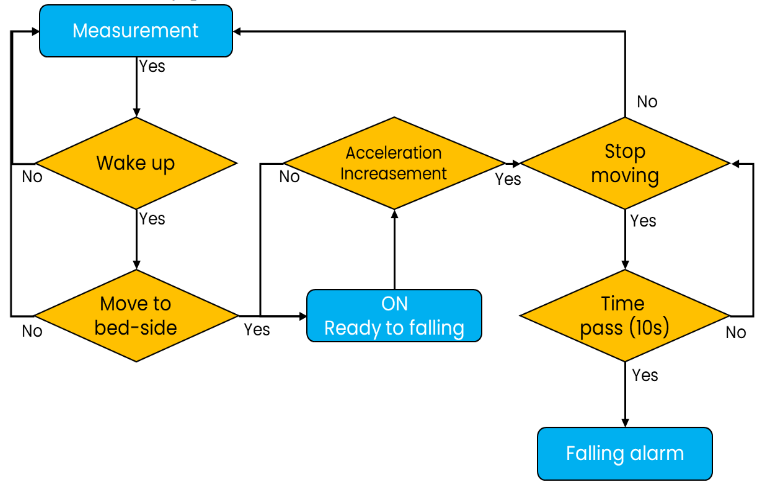Development of Commercialization of IoT Healthcare Sensors Customized for 60 GHz Radar
Keywords:
Radar, IoT, Healthcare, Elderly, AIAbstract
The aging population, the elderly living alone, and the increase in lonely deaths are global social problems. The rising aging population due to an increase in life expectancy and decrease in fertility rates is emerging as an issue except for some developing countries with high fertility rates. According to the results of the 2015 Population and Housing Census, the elderly population aged 65 or older in 2015 was 13.2% of the total population, which is just before the aging society, and 19.8% in 2025, which is expected to be close to the super-aged society. One of the problems of an aging society is the lack of caregivers in homes for the aged because the shortage imposes increasing workloads on caregivers and leads to the deterioration of the quality of care for the elderly. Furthermore, preventive care policies are needed for healthy elderly people, who are potential care consumers who account for more than 80% of the total elderly population, before their health deteriorates in the future due to the absence of services. To solve these problems, we conducted a new type of elderly-friendly study that monitors sleep, movement, and the heart rate of the elderly using contactless radar sensors, and overcomes the limitations of existing face-to-face welfare services as a smart healthcare device that can respond quickly with related institutions in an emergency. As a result, recognition accuracy of 97.65% and an F1-Score of 92.59% were shown. If this is applied to the health and welfare service area, which has traditionally developed around face-to-face services, by combining the Internet of Things (IoT) and radar technology, personalized AI care services can be innovated through sleep and lifestyle analysis for the elderly.
Downloads
References
Korea Ministry of Health and Welfare, (2021), Customized care services for the elderly Retrieved from:
https://www.mohw.go.kr/react/policy/index.jsp?PAR_MENU_ID=06&MENU_ID=06390104&PAGE=4&topTitle=
Korea Census, (2015), A Study on the older drug status and activities, Retrieved from:
Malla, S., M. J. . Meena, O. . Reddy. R, V. . Mahalakshmi, and A. . Balobaid. “A Study on Fish Classification Techniques Using Convolutional Neural Networks on Highly Challenged Underwater Images”. International Journal on Recent and Innovation Trends in Computing and Communication, vol. 10, no. 4, Apr. 2022, pp. 01-09, doi:10.17762/ijritcc.v10i4.5524.
Yanjie Han, Yingzi Yuan, Li Zhang & Yanru Fu, SLEEP DISORDER STATUS OF NURSES IN GENERAL HOSPITALS AND ITS INFLUENCING FACTORS, Psychiatria Danubina, 2016; Vol. 28, No. 2, pp 176-183
Suman Rani, Kiran Singh, and Arti Kumari, Study of sleep disorder in elderly: A review, Indian Journal of Health and Well-being 2019, 10(4-6), pp 95-97
Goran Medic, Micheline Wille, and Michiel EH Hemels, Short- and long-term health consequences of sleep disruption, Nat Sci Sleep. 2017; 9: pp 151–161. doi: 10.2147/NSS.S134864
Jennifer L. Martin, PhD1 and Sonia Ancoli-Israel, PhD2, SLEEP DISTURBANCES IN LONG-TERM CARE, Clin Geriatr Med. 2008 Feb; 24(1): 39–vi. doi: 10.1016/j.cger.2007.08.001
Kabisha, M. S., Rahim, K. A., Khaliluzzaman, M., & Khan, S. I. (2022). Face and Hand Gesture Recognition Based Person Identification System using Convolutional Neural Network. International Journal of Intelligent Systems and Applications in Engineering, 10(1), 105–115. https://doi.org/10.18201/ijisae.2022.273
Statistics Korea, 2020 statistics for the elderly, (2020), Retrieved from:
http://kostat.go.kr/portal/korea/kor_nw/1/1/index.board?bmode=read&aSeq=385322
BCC Research, Technologies for Long-term Care and Home Healthcare: Global Markets, (2016), Research and Markets
Shatnawi, M. Q., & Alazzam, B. (2022). An Assessment of Eclipse Bugs’ Priority and Severity Prediction Using Machine Learning. International Journal of Communication Networks and Information Security (IJCNIS), 14(1). https://doi.org/10.17762/ijcnis.v14i1.5266
Nature, Shuai Xu , Arun Jayaraman & John A. Rogers, Skin sensors are the future of health care, (2017), https://www.nature.com/articles/d41586-019-02143-0
Currie L. Fall and Injury Prevention. In: Hughes RG, editor. Patient Safety and Quality: An Evidence-Based Handbook for Nurses. Rockville (MD): Agency for Healthcare Research and Quality (US); 2008 Apr. Chapter 10. Retrieved from: https://www.ncbi.nlm.nih.gov/books/NBK2653/

Downloads
Published
How to Cite
Issue
Section
License

This work is licensed under a Creative Commons Attribution-ShareAlike 4.0 International License.
All papers should be submitted electronically. All submitted manuscripts must be original work that is not under submission at another journal or under consideration for publication in another form, such as a monograph or chapter of a book. Authors of submitted papers are obligated not to submit their paper for publication elsewhere until an editorial decision is rendered on their submission. Further, authors of accepted papers are prohibited from publishing the results in other publications that appear before the paper is published in the Journal unless they receive approval for doing so from the Editor-In-Chief.
IJISAE open access articles are licensed under a Creative Commons Attribution-ShareAlike 4.0 International License. This license lets the audience to give appropriate credit, provide a link to the license, and indicate if changes were made and if they remix, transform, or build upon the material, they must distribute contributions under the same license as the original.





